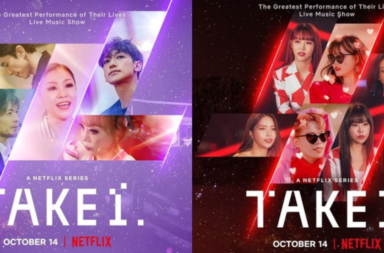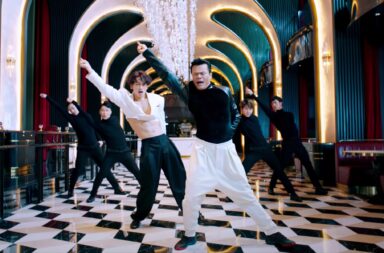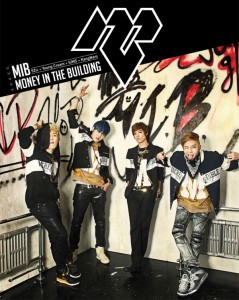 Unbeknownst to some, there are several labels in K-pop which either specialize or focus specifically on marketing “hip hop” artists. Upon examining the type of acts associated with these labels, one would discover a hierarchy that these “hip hop” labels fall into, one which is comparable to the hierarchy that sits atop the entire K-pop industry, the Big Three. YG Entertainment, the original “hip hop” label, would ironically be the SM Entertainment of the hip hop world. It is by far the largest and most successful label which lays somewhat of a claim to the “hip hop” genre (just to clarify, “hip hop” in quotations means that I’m using the term very loosely). Amoeba Culture would be considered the YG of hip hop because it’s the one label that is attempting to stay true to the genre. It signs legitimate hip hop artists for their talent and skills, and not for their looks and glam. It’s the one label which harvests artists and not idols and attempts to bring them into the mainstream, a rare spectacle these days.
Unbeknownst to some, there are several labels in K-pop which either specialize or focus specifically on marketing “hip hop” artists. Upon examining the type of acts associated with these labels, one would discover a hierarchy that these “hip hop” labels fall into, one which is comparable to the hierarchy that sits atop the entire K-pop industry, the Big Three. YG Entertainment, the original “hip hop” label, would ironically be the SM Entertainment of the hip hop world. It is by far the largest and most successful label which lays somewhat of a claim to the “hip hop” genre (just to clarify, “hip hop” in quotations means that I’m using the term very loosely). Amoeba Culture would be considered the YG of hip hop because it’s the one label that is attempting to stay true to the genre. It signs legitimate hip hop artists for their talent and skills, and not for their looks and glam. It’s the one label which harvests artists and not idols and attempts to bring them into the mainstream, a rare spectacle these days.
Then there’s the rest. Brand New Music is like Cube Entertainment in that it has a huge roster of established artists, but still fails to promote them as well as the Big Three. Stardom Entertainment would then be like A-Cube if Cube, its parent company, had decided to part ways with it and the PD of A-Cube had run off with all of its cash . That leaves us with Jungle Entertainment. The label founded under Tiger JK, a legendary hip hop artist himself who rose from the underground to find mainstream success, Jungle is reminiscent of JYP Entertainment in that its artists tend to come off as overly angst-ridden and melancholic.
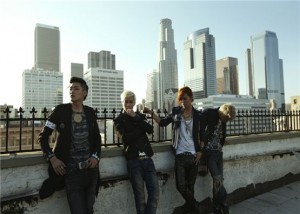 If this completely off-the-wall analogy is anywhere near accurate, then M.I.B would be like the 2PM of hip hop, but in reverse. Whereas 2PM underwent their emo phase first then went through a club-banging phase later (and are now threatening to revert to their former depressed selves), M.I.B got their party-going indulgences out of the way and have now gotten in touch with their emotional side. After the promotional releases of upbeat tracks “G.D.M” and “Celebrate,” the dorm fire incident which caused the tragic deaths of several of their staff members influenced M.I.B to return to the scene last July with a more sensitive personality. “Only Hard for Me” showed a deeper, more sentimental side to the boys that audiences found more agreeable. The heartbreaking tone of the song’s relaxed pace paired with the incredible backdrop of Los Angeles in the MV allowed audiences to sympathize with their loss.
If this completely off-the-wall analogy is anywhere near accurate, then M.I.B would be like the 2PM of hip hop, but in reverse. Whereas 2PM underwent their emo phase first then went through a club-banging phase later (and are now threatening to revert to their former depressed selves), M.I.B got their party-going indulgences out of the way and have now gotten in touch with their emotional side. After the promotional releases of upbeat tracks “G.D.M” and “Celebrate,” the dorm fire incident which caused the tragic deaths of several of their staff members influenced M.I.B to return to the scene last July with a more sensitive personality. “Only Hard for Me” showed a deeper, more sentimental side to the boys that audiences found more agreeable. The heartbreaking tone of the song’s relaxed pace paired with the incredible backdrop of Los Angeles in the MV allowed audiences to sympathize with their loss.
About ten months later, M.I.B returns with “Nod Along.” What at first may seem like a fun party song, with its silly imperative of a title, turns out to be yet another dramatic song about not getting over a past relationship. Before I talk about the MV for “Nod Along,” let’s first address the controversy surrounding it. The scene where member SIMS is presented rapping with his full body above the sunroof of a supposedly moving car while his legs are firmly planted inside the vehicle seems rather tame compared to some of the other violent and unlawful images displayed in MVs for the sake of sensationalism. But before we criticize this as the intentional media play that it is for the mere sake of drawing attention to the group and the MV, let’s not forget that other idols have been condemned for traffic violations of a much lesser degree.
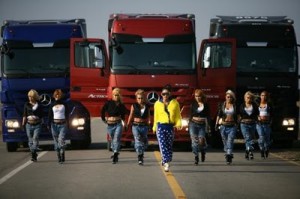 Hyori’s 2010 comeback was not only marred by allegations of plagiarism on her album, but was also undercut by broadcasting stations which banned the MV of her lead single, “Chitty Chitty Bang Bang,” from regular broadcasting (only to be unbanned later after the MV was given a major liposuction) because of several traffic violations. Examples of such roadside lawlessness cited in the MV included acts of not wearing a seat belt while operating a moving vehicle and provocative dancing in the middle of the road in front of a police roadblock no less. As for why HyunA didn’t get a ban for running over a clown with an ice cream truck in her MV for “Ice Cream,” well I partially explain that here.
Hyori’s 2010 comeback was not only marred by allegations of plagiarism on her album, but was also undercut by broadcasting stations which banned the MV of her lead single, “Chitty Chitty Bang Bang,” from regular broadcasting (only to be unbanned later after the MV was given a major liposuction) because of several traffic violations. Examples of such roadside lawlessness cited in the MV included acts of not wearing a seat belt while operating a moving vehicle and provocative dancing in the middle of the road in front of a police roadblock no less. As for why HyunA didn’t get a ban for running over a clown with an ice cream truck in her MV for “Ice Cream,” well I partially explain that here.
Rain was also hit with a ban in 2010 for his MV of “Love Song” for, get this, sprinting recklessly across the road! It’s not like he even put himself in harm’s way or was tragically struck down by a car. The man was just running, albeit very intensely, and was in no clear danger! By this logic, MVs for JYJ’s “In Heaven” and FT Island’s “Severely” never should have reached the airwaves during hours when children are likely to be out and about either. And has anyone seen this MV released last year by Kim Jyn Pyo featuring G.NA (portrayed in the video by Nara of Hello Venus), “Sorry that I’m Sorry?”
[youtube https://www.youtube.com/watch?v=f6ScarEBlD0&w=560&h=315]I lost count halfway through the MV how many traffic laws were being broken, but where were the public reactions and outcries to this? Then netizens suddenly have the right to get all crazy when Eunji of A Pink hangs a bag of oranges outside of a car she was safely secured in, seatbelt and everything? KBS decides to ban Psy‘s new MV because he kicked a traffic cone? Where is the consistency and the logic? Most importantly, why are broadcasting stations so concerned about its celebrities upholding traffic laws?
 The only way I can rationalize these different reactions and non-reactions by broadcasting stations to the public’s supposed over-temperament to seeing celebrities violate traffic laws on camera or on screen is that the public only make a big deal out of it when it’s an artist that they actually care about. Aside from the examples cited of JYJ and FT Island, both of which are actually just conventional plot devices very commonly used in dramas and films, it seems that the public cares only when high profile figures get involved in such controversies. Rain, Hyori, Eunji, and Psy were/are all very popular at the time of their traffic defiance. Kim Jyn Pyo, not so much.
The only way I can rationalize these different reactions and non-reactions by broadcasting stations to the public’s supposed over-temperament to seeing celebrities violate traffic laws on camera or on screen is that the public only make a big deal out of it when it’s an artist that they actually care about. Aside from the examples cited of JYJ and FT Island, both of which are actually just conventional plot devices very commonly used in dramas and films, it seems that the public cares only when high profile figures get involved in such controversies. Rain, Hyori, Eunji, and Psy were/are all very popular at the time of their traffic defiance. Kim Jyn Pyo, not so much.
Which brings us back to these Most Incredible Busters – why are news reports making such a big deal about SIMS’ body protruding through the top of a sunroof of a car that barely seems like its even in motion? Is it because M.I.B is suddenly a much-loved and well-known group, or is this simply what most suspected from the beginning, a media play? I think the answer is quite clear.
Now that we got that out of the way, we can finally talk about the song and its MV. The music structure of “Nod Along” is very similar to that of “Only Hard for Me” – a heartfelt chorus is immersed with very reflective rap verses. This time around, the beat is more electronic, the raps are sped up and more intense, and Cream is stuck with this overly autotuned rap sing verse which is catchy at first but proceeds to become overbearing upon further listens. The song is still very catchy, nonetheless, and an overall pleasant listen.
[youtube https://www.youtube.com/watch?v=NizMeKcnTu8&w=560&h=315] The MV, on the other hand, lacks direction to say the least. In what initially seemed like a plot-centered MV focusing on an overturned car with a girl in it, we suddenly transition to a police scene where Cream is this singing corpse with an autotune device lodged in his throat. The plot unfortunately does not develop from there as we proceed to see Kangnam in a room by himself swallowing a Matrix-style blue pill while 5zic and SIMS are out breaking traffic laws. My best guess towards what is going on is that while the two were out on their roadside rampage, they accidentally ran over their buddy Cream, caused that car with the girl in the beginning to flip over amidst their panic while fleeing the scene, and forgot to pick up Kangnam who decided to take Morpheus’ blue pill to remain in the world of the Matrix, which is still a whole lot better than the reality of this MV he had found himself in.
The MV, on the other hand, lacks direction to say the least. In what initially seemed like a plot-centered MV focusing on an overturned car with a girl in it, we suddenly transition to a police scene where Cream is this singing corpse with an autotune device lodged in his throat. The plot unfortunately does not develop from there as we proceed to see Kangnam in a room by himself swallowing a Matrix-style blue pill while 5zic and SIMS are out breaking traffic laws. My best guess towards what is going on is that while the two were out on their roadside rampage, they accidentally ran over their buddy Cream, caused that car with the girl in the beginning to flip over amidst their panic while fleeing the scene, and forgot to pick up Kangnam who decided to take Morpheus’ blue pill to remain in the world of the Matrix, which is still a whole lot better than the reality of this MV he had found himself in.
Overall MV Rating: 2.5 out of 5
Readers, what are your rationalizations of the MV’s plot and K-pop’s many inexplicable and seemingly random traffic violation controversies?
(Naver 1, 2, 3, Nate, Daum, YouTube 1, 2, Images via Jungle Entertainment, Mnet Media, A Pink’s me2day)

